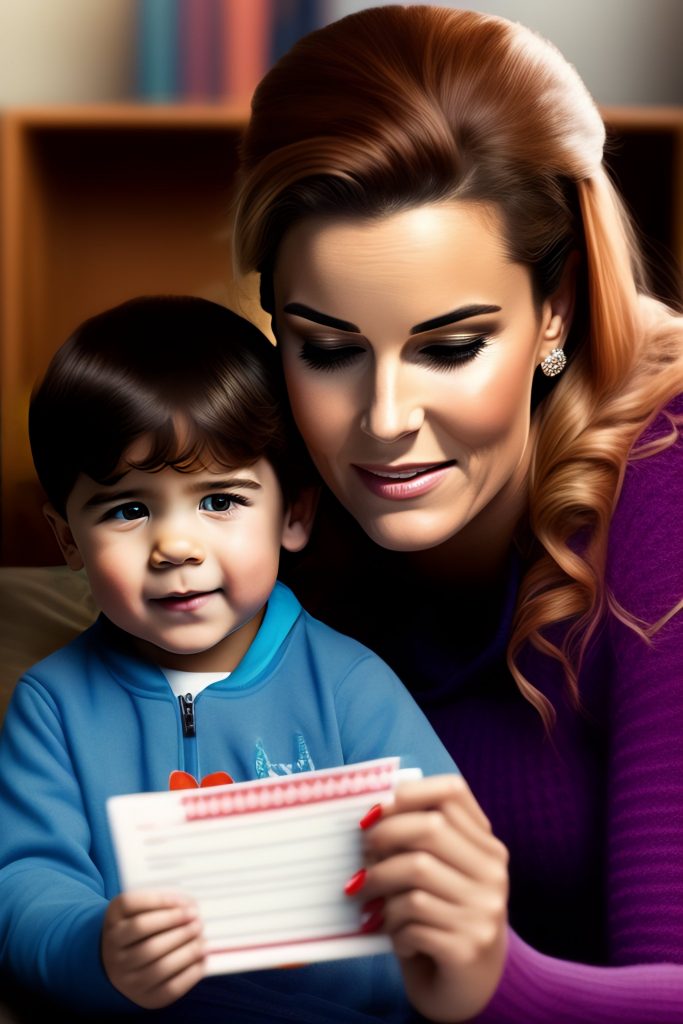- Set clear expectations and boundaries for behavior.
When it comes to dealing with misbehaving children, setting clear expectations and boundaries is an important part of effective discipline. This involves establishing a clear set of rules and guidelines for behavior, as well as consequences for breaking those rules.
To set clear expectations and boundaries, it’s important to be specific and consistent. This means defining what behaviors are acceptable and unacceptable, and communicating these expectations clearly and directly to the child. It’s also important to explain the reasoning behind these rules, so that the child understands why they are important.
In addition to setting clear expectations, it’s also important to establish consequences for misbehavior. These consequences should be appropriate to the behavior in question, and should be communicated to the child in advance. This helps to create a sense of predictability and fairness, and can make it easier for the child to understand the consequences of their actions.
It’s also important to enforce these expectations and boundaries consistently. This means following through with consequences when rules are broken, and not making exceptions or excuses. This consistency can help to establish a sense of structure and routine for the child, which can be particularly important for children who struggle with impulse control or have difficulty regulating their behavior.
Overall, setting clear expectations and boundaries is an important part of effective discipline for misbehaving children. By being specific, consistent, and fair, parents and caregivers can help children understand what is expected of them, and can provide a sense of structure and predictability that can be beneficial for both the child and the caregiver.
Here’s an example of “Set clear expectations and boundaries for behavior” in a real-life situation:
Let’s say a parent has a 5-year-old child who has a habit of interrupting adult conversations. The parent can set clear expectations and boundaries for the child’s behavior by explaining that interrupting is not polite and can be disruptive to the conversation. The parent can then establish a specific rule, such as “If Mom or Dad are talking to another adult, you need to wait until we’re finished before asking a question or talking to us.”
To reinforce this expectation, the parent can praise the child when they wait patiently, and consistently remind the child of the rule when they start to interrupt. If the child does interrupt, the parent can calmly but firmly remind them of the rule and enforce a consequence, such as a time-out or loss of a privilege.
Over time, the child will learn that interrupting is not acceptable and will develop the habit of waiting patiently for their turn to speak. By setting clear expectations and boundaries for behavior, the parent is helping the child learn important social skills that will benefit them throughout their life.
2. Use positive reinforcement and praise good behavior.
Positive reinforcement is a powerful tool for encouraging good behavior in children, including those who may be prone to misbehaving. Positive reinforcement involves providing rewards or praise for good behavior, with the goal of encouraging that behavior to continue in the future.
When it comes to misbehaving children, positive reinforcement can be particularly effective. This is because misbehaving children often receive a lot of negative attention and consequences for their behavior, which can lead to a cycle of negative behavior. By providing positive reinforcement for good behavior, parents and caregivers can help to break this cycle and encourage more positive behavior in the future.
One way to use positive reinforcement is to provide praise for good behavior. This might include things like telling a child that they did a good job, thanking them for following the rules, or complimenting them on their behavior. This positive attention can be a powerful motivator for children, and can help to reinforce the behavior that you want to see more of.
Another way to use positive reinforcement is to provide rewards for good behavior. This might include things like a small treat, extra playtime, or the opportunity to choose a special activity. These rewards should be appropriate to the behavior in question, and should be something that the child will find motivating.
It’s important to note that positive reinforcement should be used alongside clear expectations and consequences for misbehavior. While it’s important to provide positive attention and rewards for good behavior, it’s also important to establish clear boundaries and consequences for misbehavior. By combining positive reinforcement with clear expectations and consequences, parents and caregivers can create a balanced approach to discipline that encourages good behavior and discourages misbehavior.
here’s an example of “positive reinforcement and praise good behavior :
Margaret was in the produce aisle of the grocery store, haggling with her four-year-old daughter, Sarah, over a toy she wanted. Sarah was throwing a temper tantrum and was determined to get her way and Margaret was determined not to give in.
It had been a long day, and Margaret was exhausted. She had stopped at the store on the way home from work to buy some produce for dinner and Sarah had insisted on getting a toy from the aisle. Margaret had said no, but Sarah had not taken no for an answer.
Margaret had to remain firm and not give in to Sarah’s tantrum, so she calmly tried reasoning with her. “Sarah, if you can be patient and wait until we get home then I promise that you can have your toy. But here in the store, we can’t buy it.”
Sarah continued to cry and shout at Margaret, but Margaret stayed calm and instead of scolding her, she praised her. “Sarah, I understand that you want the toy very much. I know how hard it is to wait. But you are doing a good job of trying to use your words to tell me how you feel. That’s very mature of you.”
Sarah stopped her tantrum and looked up at Margaret with surprise. Margaret had just praised her. She continued in a gentle voice, “You’re doing a great job of using your words to express your feelings. That shows me that you’re growing up and understanding how to talk about your needs. I’m very proud of you for that.”
Sarah smiled at her mom and nodded her head. Margaret hugged her tightly and said, “Now, let’s try to find something else to buy at the store.”
As they continued down the aisle, Sarah was much calmer and was able to focus on the task at hand. Margaret continued to reward her daughter’s good behavior with praise. She acknowledged Sarah’s efforts to stay calm and make good choices. “I can see that you’re really trying your best. You’re doing such a great job. I knew you could do it.”
Sarah beamed with pride and Margaret was proud of her daughter’s newfound patience. She had used positive reinforcement to encourage good behavior in her daughter, and it had worked.
They finished their shopping and went home. As promised, Margaret gave Sarah the toy as a reward for her good behavior. Sarah was ecstatic and Margaret was happy that her daughter was so pleased. Margaret knew that this was a valuable lesson for her daughter and that positive reinforcement was a powerful tool in parenting. She vowed to continue to use it in the future.
3. Use consistent consequences for misbehavior.
Using consistent consequences for misbehavior is an important aspect of effective discipline for misbehaving children. Consistent consequences help children understand what is expected of them and what will happen if they engage in misbehavior. This consistency provides a sense of structure and routine, which can be particularly important for children who struggle with impulse control or have difficulty regulating their behavior.
When using consistent consequences, it’s important to be clear and specific about what behaviors will result in consequences. This might include things like breaking rules, being disrespectful, or engaging in harmful behavior. The consequences themselves should also be clear and consistent, so that the child understands what will happen if they engage in misbehavior.
here’s an example of “Use consistent consequences for misbehavior” in a real-life situation:
Let’s say a parent has a 10-year-old child who has a habit of not doing their homework. The parent can use consistent consequences for misbehavior by establishing a specific rule, such as “You need to complete your homework before you can watch TV or play video games.”
To reinforce this expectation, the parent can praise the child when they complete their homework on time, and consistently remind the child of the rule when they start to neglect their homework. If the child doesn’t complete their homework, the parent can calmly but firmly remind them of the rule and enforce a consequence, such as a loss of screen time or a grounding from social events.
It’s important that the consequences are applied consistently, so that the child understands that the rule is non-negotiable. By doing this, the child learns that there are consequences to their actions, and that they are responsible for their own behavior. Over time, the child will develop the habit of completing their homework on time, and will become more responsible and self-disciplined.
4. Communicate calmly and clearly when addressing misbehavior.
Communicating calmly and clearly when addressing misbehavior in children is an essential skill that all parents should strive to master. It is important to recognize that children will inevitably misbehave, and that it is the parent’s job to effectively and calmly intervene. In order to effectively address misbehavior, it is essential to understand the underlying causes behind it. Misbehavior can stem from a variety of sources, including lack of understanding, frustration, seeking attention, or test of limits.
In order to effectively address misbehavior, it is important to remain calm, clear, and consistent. It is essential not to react too harshly to misbehavior, as this can lead to further issues in the future. It is important to remain consistent with expectations and consequences, as this will help the child understand the boundaries and expectations from the parent.
here’s an example of “Communicate calmly and clearly when addressing misbehavior.”
One example of addressing misbehavior in a calm and clear manner is when a child is throwing a tantrum. It is important to stay calm and not get involved in a screaming match with the child. Instead, it is important to remain firm and remind the child of the expectations for behavior. It is important to avoid yelling and remain level-headed in order to get the child to understand that throwing a tantrum is not acceptable behavior.
Another example of addressing misbehavior in a calm and clear manner is when a child is being disrespectful. It is important to remain calm and not to get angry. Instead, it is important to remain firm and remind the child of the expectations for respectful behavior. It is also important to explain why the behavior is inappropriate and how it is affecting others.
It is also important to make sure that the consequences of misbehavior are clear and consistent. For example, if a child is misbehaving, it is important to be clear about the consequences that will follow. It is also important to make sure that the consequences are consistent and something the child can understand and follow. For example, if a child misbehaves in the store, it is important to make sure that the child understands that there will be no more store visits for a certain period of time. This will help the child understand the consequences of misbehavior and will help them internalize the expectation for respectful behavior.
It is also important to understand that children are still learning and will make mistakes. It is important to be understanding and to reinforce positive behavior rather than focusing on the negative. Praise can be an effective tool to help the child understand that they are expected to behave appropriately. Similarly, it is important to be patient and to give the child time to understand the expectations and consequences.
Ultimately, it is important to remember that communicating calmly and clearly when addressing misbehavior in children is an essential skill that all parents should strive to master. With patience and understanding, it is possible for parents to effectively address misbehavior in children in a calm and clear manner. By remaining consistent with expectations and consequences, understanding the underlying causes of misbehavior, and reinforcing positive behavior, parents can ensure that their children understand the expectations and consequences of misbehavior.
5. Give the child choices and involve them in decision making.
Child choices and involving them in decision making is an important part of parenting that helps children to become independent, confident, and responsible individuals. It helps them learn to make their own decisions and express their own feelings, while also providing a foundation for effective communication and problem solving.
here’s an example of “Give the child choices and involve them in decision making:
One real life example of this is when parents encourage their children to make their own decisions. For example, when my son was three years old, we started encouraging him to pick out his own clothes each day. We would bring him to the closet, and let him choose what he wanted to wear. We would offer some suggestions and guidance, such as pointing out that it was cold out and he should wear a coat, but ultimately we let him decide.
This was an important lesson for him in decision making, and it gave him a sense of autonomy. He was learning how to make his own choices and express his own opinions. He was also learning how to listen to our suggestions, and then make his own decision based on that.
Another example of involving children in decision making is when we let them participate in family discussions. We will often sit down and talk about different topics, such as what we should do for the holidays or where we should go for vacation. We will ask my son for his opinion and let him voice his ideas. We may also ask him to help us make decisions and give us his input. This helps him to feel involved in the decisions that are being made in the family, and it shows him that his opinion is important.
It is also important to involve children in decisions that directly affect them. For instance, when my son was in kindergarten, we allowed him to help decide which after-school activities he wanted to participate in. We gave him a few options, such as karate or piano lessons, and asked him which one he wanted to do. We also asked him why he wanted to do the activity and what he thought he would gain from it. This empowered him to make his own decisions, and it gave us an opportunity to discuss the pros and cons of each activity and which one would be the best fit for him.
As children grow older, it is important to continue to involve them in decision making. For example, when my son was in middle school, we started allowing him to make decisions about his weekend plans. We would talk about what activities he wanted to do, such as going to the movies or going to the park, and we would give him some ideas. We would also make sure to discuss any concerns we had and explain why certain activities were not a good choice. We also encouraged him to come up with his own ideas and allowed him to make the final decision.
Overall, child choices and involving them in decision making is an important part of parenting that helps children to become independent, confident, and responsible individuals. It helps them learn to make their own decisions and express their own feelings, while also providing a foundation for effective communication and problem solving. By involving children in decisions that directly affect them, we not only empower them to make their own decisions but also give them a sense of ownership and responsibility.
6. Stay calm and avoid reacting emotionally.
The experience of being a parent can be both rewarding and challenging. One of the greatest challenges for parents is dealing with a child who is misbehaving. When parents are faced with this difficult situation, it is important to stay calm and to avoid reacting emotionally. Doing so can help parents to effectively address the misbehavior and help the child learn from the experience.
It can be difficult for parents to stay calm when their child is misbehaving. In many cases, parents feel frustrated and angry and may have an impulse to yell or react in an overly emotional way. This reaction can often escalate the situation and make the child more likely to continue the misbehavior.
The best approach for parents when a child is misbehaving is to remain calm. This means taking a deep breath and counting to ten before responding. Taking a few moments to pause can give the parent the opportunity to think clearly and respond in a more appropriate manner.
The next step is to identify the underlying cause of the misbehavior. By understanding why the child is acting out, it is possible to intervene in a more effective way. For example, if a child is having difficulty following directions, it may be due to a lack of understanding of what is expected. Taking the time to explain the expectations clearly can help the child to better understand and comply with the directions.
When addressing the misbehavior, it is important for parents to remain calm and to use language that is respectful. Yelling and using harsh words can make the child feel ashamed and embarrassed and can make it more difficult for the child to learn from the experience. Instead, it is better for parents to use language that is firm yet understanding.
It is also important for parents to provide the child with positive reinforcement when he or she behaves in an appropriate manner. By doing this, the child is more likely to continue to behave in a way that is socially acceptable.
In some cases, a misbehaving child may need more help in order to learn how to behave in a more appropriate way. If this is the case, it is important for parents to seek out the help of a professional, such as a therapist or counselor, who can help the child to learn how to better regulate his or her emotions and behavior.
here’s an example of “Stay calm and avoid reacting emotionally:
Let’s say a child is playing with a toy car and accidentally knocks over a vase, breaking it. The child becomes upset and starts to cry, while the parent or caregiver feels frustrated and angry about the broken vase.
If the parent or caregiver reacts with anger or frustration, it can exacerbate the child’s upset and make it more difficult to address the misbehavior. However, if the parent or caregiver stays calm and avoids reacting emotionally, it can help to create a sense of safety and security for the child, making it easier to address the situation.
In this case, the parent or caregiver might take a deep breath and calmly approach the child. They might say something like, “It’s okay, accidents happen. Let’s clean this up together.” By staying calm and avoiding an emotional reaction, the parent or caregiver can create a sense of safety and reassurance for the child, while also addressing the misbehavior in a constructive and supportive way.
This approach can help the child to feel more confident and empowered to learn from their mistake and avoid similar misbehavior in the future. By staying calm and avoiding an emotional reaction, parents and caregivers can create a positive and supportive environment that encourages positive behavior and helps children learn and grow.
In conclusion, it is important for parents to stay calm and avoid reacting emotionally when their child is misbehaving. Doing so can help to prevent the situation from escalating and can help the child learn from the experience. It is also important for parents to take the time to identify the root cause of the misbehavior and to provide positive reinforcement when the child behaves appropriately. Finally, if necessary, parents should seek out appropriate help from a professional to ensure that their child learns how to behave in a socially acceptable way.
7. Use distraction techniques to redirect misbehavior.
Distraction techniques are a useful tool for redirecting misbehavior in children. The idea behind distraction is to shift the child’s attention away from the problematic behavior by providing an interesting and engaging alternative activity. Here’s how you can use distraction techniques to redirect misbehavior in children:
- Identify the problematic behavior: Observe the child’s behavior and identify the specific behavior that needs to be redirected. For example, if the child is throwing a tantrum because they don’t want to leave the playground, the problematic behavior is the tantrum.
- Offer a positive alternative: Offer the child an alternative activity that is interesting and engaging. This can help to shift their focus away from the problematic behavior. For example, you might suggest going to get ice cream or playing a game in the car on the way home.
- Provide a clear and positive explanation: Explain the alternative activity in a clear and positive way. For example, “Let’s go get ice cream now and we can come back to the playground tomorrow when it’s not so crowded.”
- Follow through: Make sure that you follow through with the alternative activity. This will help to reinforce the idea that the alternative activity is a positive and rewarding experience.
Here’s an example of how you can use distraction techniques to redirect misbehavior in a child:
Imagine a child is throwing a tantrum in a store because they want a toy that their parent won’t buy. The parent could use distraction techniques to redirect the child’s behavior. The parent could say, “Hey, look at this cool game we can play on our phones while we wait in line! Let’s see who can get the highest score.” By offering the child a positive alternative activity, the parent can shift the child’s focus away from the toy they can’t have and onto the game they can play with their parent. This can help to defuse the situation and prevent a full-blown tantrum.
8. Address the behavior, not the child’s character.
Address the behavior, not the child’s character” is an important principle in positive parenting and education. It means that when giving feedback or correction to a child, it is important to focus on the specific behavior that needs to be changed, rather than making judgments about the child’s character or personality.
This approach helps to separate the child’s actions from their sense of self-worth, and promotes a growth mindset in which mistakes are seen as opportunities for learning and improvement.
Here’s an example of how to apply this principle in real life:
Imagine that a child comes home from school with a report card that has lower grades than expected. A parent who is addressing the behavior might say, “I noticed that your grades in math and science are lower than they were last semester. Let’s talk about what we can do to help you improve your understanding of these subjects.” This approach focuses on the behavior of the child’s grades and offers a solution to improve them.
On the other hand, a parent who addresses the child’s character might say, “You’re not smart enough to do well in math and science. You’re not applying yourself and you’re not taking it seriously.” This approach makes a negative judgment about the child’s character and might make them feel discouraged, which could negatively impact their future academic performance.
By addressing the behavior and not the child’s character, the parent can provide constructive feedback that is focused on helping the child improve, rather than making them feel bad about themselves. This approach can help the child to see mistakes as opportunities for growth and learning, rather than something to be ashamed of.
9. Avoid using physical punishment.
It is important to avoid using physical punishment as a means of correcting misbehaving children. Physical punishment can cause harm to the child, both physically and emotionally, and can have negative long-term effects on their behavior and mental health. Here are a few reasons why it’s important to avoid physical punishment:
- Physical punishment can be harmful: Physical punishment can cause physical harm, such as bruises, cuts, and even broken bones. It can also cause emotional harm, such as feelings of shame, anxiety, and depression.
- Physical punishment can escalate: Physical punishment can escalate over time, becoming more severe and even abusive. It can also lead to children becoming aggressive and using violence as a way to solve problems.
- Physical punishment doesn’t address the root cause of misbehavior: Physical punishment doesn’t address the underlying causes of misbehavior, such as a lack of understanding or skills. It only addresses the behavior in the moment, without providing the child with tools to address the problem in the future.
Here’s an example of why it’s important to avoid physical punishment in real life:
Imagine a child is misbehaving by throwing a tantrum in a grocery store because they want a candy bar. A parent who uses physical punishment might spank the child or slap them on the wrist. This can cause physical and emotional harm to the child, and it doesn’t address the root cause of the misbehavior, which is the child’s desire for the candy bar.
A parent who avoids physical punishment might use distraction techniques to redirect the child’s attention away from the candy bar, or explain why it’s not healthy to eat too much candy.
This approach addresses the behavior in a positive and constructive way, without causing harm to the child. It also provides the child with tools to address the problem in the future, such as learning about healthy eating habits.
10. Use time-outs or removal from the situation as a consequence.
Using time-outs or removal from a situation as a consequence for misbehavior can be an effective way to teach children to take responsibility for their actions and learn from their mistakes. Here are a few reasons why using time-outs or removal as a consequence can be effective:
- It is a non-physical consequence: Time-outs or removal from a situation are non-physical consequences that don’t involve hitting, spanking, or physical harm. This approach helps to keep the child safe and allows them to learn from their mistakes without being physically hurt.
- It gives the child time to calm down: Time-outs or removal from a situation can give the child time to calm down and reflect on their behavior. This can help them to learn to self-regulate their emotions and behavior, and to take responsibility for their actions.
- It can be a teaching moment: Time-outs or removal from a situation can be used as a teaching moment to help the child understand why their behavior was inappropriate and to help them learn to make better choices in the future.
Here’s an example of how to use time-outs or removal from a situation as a consequence in real life:
Imagine a child is misbehaving by hitting their sibling during a play-date. The parent could use time-out as a consequence by taking the child to a quiet room or corner, and explaining that hitting is not an appropriate way to solve problems.
The child is then left alone for a brief period of time, such as a minute per year of age, to calm down and reflect on their behavior. After the time-out, the parent could rejoin the child and explain why their behavior was inappropriate and discuss better ways to solve problems in the future, such as using words to express their feelings.
In this example, the time-out provides the child with an opportunity to calm down and think about their behavior. It also allows the parent to address the behavior in a positive and constructive way, teaching the child to take responsibility for their actions and to learn from their mistakes.
11. Model appropriate behavior yourself.
Modeling appropriate behavior is a parenting technique that involves demonstrating to children how they should behave in a specific situation. When children misbehave, modeling appropriate behavior can help them understand what they should be doing instead of the unwanted behavior.
When a child is misbehaving, it can be challenging for parents to know how to respond in a way that helps the child learn from the situation. Modeling appropriate behavior is one way to teach children how to behave in a positive way, rather than simply punishing or scolding them for their misbehavior.
To model appropriate behavior, parents should first identify the specific behavior they want to encourage in their child. For example, if the child is being aggressive towards others, the parent may want to model how to communicate calmly and resolve conflicts peacefully.
Once the desired behavior has been identified, parents can demonstrate the behavior by role-playing the situation with the child. This can involve talking the child through the desired behavior or demonstrating it themselves. The parent should make sure to use positive language and praise the child when they demonstrate the desired behavior.
Modeling appropriate behavior can also involve teaching children problem-solving skills. For example, if a child is struggling with a task, the parent can model how to break the task down into smaller steps and work through each step methodically. This can help the child build confidence and learn how to tackle challenges in a positive way.
It is important to note that modeling appropriate behavior is not a one-time fix for misbehaving children. It is an ongoing process that requires patience and consistency on the part of the parent. Over time, as the child observes and learns from the parent’s positive behavior, they are likely to adopt those behaviors themselves.
Here’s an example of “Model appropriate behavior yourself:
Let’s say a child is constantly interrupting conversations and not listening when others are speaking. The parent or caregiver notices that they themselves sometimes interrupt conversations and talk over others.
In this situation, the parent or caregiver can model appropriate behavior themselves by consciously making an effort to actively listen when others are speaking and not interrupting. They might make an effort to pause and ask the child to wait before responding to their question or comment, and show them that they respect the other person’s need to speak and be heard.
By modeling appropriate behavior themselves, the parent or caregiver can show the child how to behave in a more respectful and considerate way. This can help the child to learn by example and understand that interrupting and talking over others is not an acceptable behavior.
Through this modeling, the parent or caregiver can also demonstrate the importance of self-awareness and personal responsibility for one’s own actions. By showing that they themselves are willing to change their behavior and learn from their mistakes, they can encourage the child to do the same.
Overall, modeling appropriate behavior yourself can be a powerful way to teach children about appropriate behavior and encourage them to develop more positive and respectful social skills.
12. Listen to and validate the child’s feelings.
“Listen to and validate the child’s feelings” means acknowledging and accepting a child’s emotions, and providing them with support and comfort. This approach helps children feel heard and understood, and can foster healthy emotional development.
To implement this approach, parents or caregivers should create a safe and supportive space for children to express their feelings. They should actively listen to the child without interrupting or dismissing their feelings. The parent or caregiver should then validate the child’s feelings by acknowledging them and showing empathy, even if they don’t necessarily agree with the child’s perspective.
For example, if a child is upset because they had an argument with a friend at school, a parent could use the following steps to listen to and validate their feelings:
- Create a safe and supportive space for the child to express their feelings. This could involve sitting down with the child in a quiet area where they feel comfortable.
- Ask the child to describe what happened and how they are feeling. Listen actively and without interruption.
- Validate the child’s feelings by acknowledging them and showing empathy. For example, the parent could say something like, “I’m sorry you had an argument with your friend. It sounds like it was really frustrating for you.”
- Encourage the child to express their emotions and thoughts further. For example, the parent could ask questions like, “What do you think caused the argument?” or “What would you like to do about the situation?”
- Provide comfort and support as needed. This could involve giving the child a hug or offering words of encouragement.
By listening to and validating the child’s feelings, the parent is helping the child learn how to manage their emotions and communicate effectively. This approach can also help build trust and strengthen the relationship between the parent and child.
13. Use natural consequences when appropriate.
Using natural consequences when appropriate” is a parenting strategy that involves allowing the natural outcome of a child’s actions to serve as a consequence for their misbehavior. This approach can help children learn responsibility and accountability for their actions, and can be a more effective way of correcting misbehavior than punishment.
Natural consequences are outcomes that occur naturally as a result of a child’s actions, without any direct intervention from a parent or caregiver. For example, if a child refuses to wear a coat on a cold day, the natural consequence is that they will feel cold and uncomfortable. If a child refuses to do their homework, the natural consequence is that they may receive a lower grade or fall behind in their studies.
To use natural consequences when appropriate, parents should first determine whether the situation is appropriate for this approach. Natural consequences should only be used when the outcome of a child’s actions is not dangerous or harmful to themselves or others. For example, natural consequences may be appropriate for situations like refusing to wear a coat or not completing homework, but not for situations like running into the street or touching a hot stove.
Once it has been determined that a natural consequence is appropriate, the parent should allow the child to experience the consequence without intervening or rescuing them. This allows the child to learn from the situation and take responsibility for their actions.
Here’s an example of “Use natural consequences when appropriate:
For example, if a child refuses to do their homework, the natural consequence may be that they receive a lower grade or fall behind in their studies. The parent should not rescue the child by doing the homework for them or allowing them to skip the assignment. Instead, the parent should allow the child to experience the consequence and use it as a learning opportunity to reinforce the importance of completing their work.
It’s important to note that using natural consequences should be done in conjunction with positive reinforcement and support for good behavior. It’s not meant to be a punitive approach, but rather a way to help children learn from their actions and take responsibility for their choices.
14. Be consistent in your responses to misbehavior.
Being consistent in your responses to misbehavior of a child means that as a parent or caregiver, you consistently respond to misbehavior in the same way every time, rather than changing your response based on your mood or the severity of the misbehavior. Consistency is important because it helps children understand what behavior is expected of them and what consequences will result from their actions.
When parents are consistent in their responses to misbehavior, children learn that certain actions always lead to the same consequences, and they are more likely to modify their behavior accordingly. This can help children feel more secure and confident in their understanding of the rules and expectations, leading to better behavior over time.
Here’s an example of “Be consistent in your responses to misbehavior:
For example, if a child is not allowed to have dessert after dinner if they don’t finish their vegetables, it’s important for the parent to consistently enforce this rule every time. If the parent lets the child have dessert without finishing their vegetables on some nights but not on others, the child may become confused and frustrated, and their behavior may not improve.
Another example might be a rule about using electronics, such as limiting screen time to one hour per day. If the child is allowed to use electronics for more than an hour on some days but not on others, they may become confused about the rules and start to push the boundaries. However, if the parent is consistent in enforcing the one-hour limit every day, the child will learn to expect the consequences and may be more likely to stick to the limit.
Consistency also helps parents avoid the pitfalls of overreacting to minor misbehavior and under reacting to more serious ones. When parents consistently enforce rules and consequences, they are less likely to be swayed by emotional responses and can focus on the behavior itself, rather than their own feelings in the moment.
In summary, consistency is a key element in effective parenting. When parents are consistent in their responses to misbehavior, they provide clear guidance and expectations for their children and help them develop better behavior over time.
15. Use a reward system to encourage good behavior.
Using a reward system to encourage good behavior in children is a parenting strategy that involves providing positive reinforcement for desired behaviors. This approach can help children develop good habits and improve their behavior over time.
The reward system works by offering something desirable to the child in exchange for engaging in positive behavior. Rewards can take many forms, such as praise, stickers, small toys, extra playtime, or special treats. The key is to offer rewards that are meaningful and motivating to the child.
To use a reward system effectively, parents should follow these steps:
- Set clear expectations: Parents should set clear expectations for the behavior they want to encourage. For example, they may want to encourage their child to do their homework without being reminded, to clean up their toys after playing, or to be polite to others.
- Define the rewards: Parents should define the rewards their child will receive for engaging in positive behavior. Rewards should be age-appropriate and something the child finds desirable. For younger children, simple rewards like stickers or small toys may work well, while older children may be motivated by more significant rewards like extra screen time or special outings.
- Track progress: Parents should track their child’s progress and provide feedback on their behavior. This can be done through a chart, where the child receives a sticker or check mark for each time they engage in positive behavior.
- Deliver the rewards: When the child reaches a predetermined number of positive behaviors, parents should deliver the reward. It’s important to be consistent and timely in delivering the reward to reinforce the desired behavior.
- Adjust the system as needed: Parents should adjust the reward system as needed to ensure it remains motivating and effective. For example, if the child loses interest in the rewards, parents may need to change them to maintain their motivation.
In summary, using a reward system to encourage good behavior in children can be an effective parenting strategy. By setting clear expectations, defining rewards, tracking progress, delivering rewards, and adjusting the system as needed, parents can help their children develop positive behaviors that will benefit them in the long run.
16. Avoid nagging or constant criticism.
Avoid nagging or constant criticism about misbehaving child” means to avoid repeatedly scolding, nagging, or criticizing a child for their misbehavior. This approach involves refraining from constantly reminding the child about their mistakes, faults, or flaws.
Nagging or constant criticism can have a negative impact on a child’s self-esteem and emotional well-being. It can also make them feel frustrated, anxious, and resentful towards the person who is constantly criticizing them. In some cases, it can even lead to a breakdown in communication and trust between the child and the caregiver.
Instead, it is important to address the child’s misbehavior in a constructive and positive manner. This can involve calmly explaining why their behavior is unacceptable, setting clear boundaries and consequences for their actions, and praising and rewarding them when they demonstrate positive behavior.
It is also important to recognize that children are not perfect and that misbehavior is a normal part of their development. As such, it is important to approach discipline with patience, empathy, and understanding, rather than with constant criticism and negativity.
Here’s an example of “Avoid nagging or constant criticism:
Let’s say a child, named Alex, is having trouble keeping their room clean. Instead of constantly reminding Alex to clean their room or criticizing them for their messiness, a parent could take a more constructive approach.
They could sit down with Alex and explain the importance of keeping their space clean and organized. They could offer to help Alex come up with a plan for keeping their room tidy, such as setting aside a specific time each day for cleaning or making a checklist of tasks to complete.
The parent could also offer praise and encouragement when Alex demonstrates positive behavior, such as cleaning their room without being asked or making an effort to keep things organized.
By avoiding nagging or constant criticism, the parent is able to maintain a positive relationship with Alex and create a supportive, non-judgmental environment for them to learn and grow. This approach is more likely to lead to long-term behavior change and a positive attitude towards cleaning and organization.
17. Use humor to diffuse tense situations.
Using humor to diffuse tense situations in misbehaving children” refers to the practice of using lighthearted jokes, playful banter, or other forms of humor to help ease tension and defuse conflicts in situations where a child is acting out or misbehaving.
When a child is misbehaving, it can create a stressful or tense situation, and this can sometimes make it difficult for parents or caregivers to communicate effectively with the child or redirect their behavior. By introducing humor into the situation, parents or caregivers can help to shift the child’s focus away from the negative behavior and towards more positive or lighthearted interactions.
Here’s an example of “Use humor to diffuse tense situations:
if a child is throwing a tantrum or acting out in public, a parent might try to distract the child by making a silly face, telling a joke, or engaging in some other playful behavior. This can help to diffuse the tension and distract the child from their negative behavior, allowing the parent or caregiver to redirect their attention in a more positive direction.
Using humor in this way can also help to create a more positive and supportive environment for the child. By injecting humor and playfulness into the situation, parents or caregivers can create a sense of levity and fun that can help to foster a closer bond with the child and create a more positive overall relationship.
18. Use logical consequences that are related to the misbehavior.

Using logical consequences that are related to the misbehavior of children” means that when a child misbehaves, the consequences of their actions are directly related to the behavior that needs to be corrected. Logical consequences are designed to help children understand the impact of their actions and to take responsibility for their behavior.
Here’s an example of “Use logical consequences that are related to the misbehavior:
if a child breaks a rule by not completing their homework, a logical consequence could be to have them complete the homework during their free time, or to miss out on a planned activity or privilege. This consequence is directly related to the misbehavior and helps the child understand that their behavior has consequences.
It’s important to note that logical consequences should be reasonable and proportional to the behavior. They should also be focused on the behavior itself, rather than the child as a person. This means that consequences should be designed to help the child learn from their actions, rather than to punish or shame them.
In addition, it’s important to make sure that consequences are consistent and predictable. This helps the child understand what is expected of them and what will happen if they don’t meet those expectations. It also helps to create a sense of fairness and equity in the discipline process.
Using logical consequences that are related to the misbehavior of children can be an effective way to teach children about responsibility and accountability. By helping children understand the consequences of their actions, parents and caregivers can guide them towards more positive behaviors and help them develop the skills they need to make good choices in the future.
19. Use problem-solving skills to find solutions to misbehavior.
Using problem-solving skills to find solutions to misbehaving children” means taking a proactive and collaborative approach to addressing misbehavior in children. Rather than simply punishing or scolding the child for their behavior, this approach involves working together with the child to identify the root causes of the behavior and to find effective solutions for addressing it.
The first step in using problem-solving skills to address misbehavior is to have a conversation with the child about the behavior. This should be done in a calm and non-judgmental manner, and should focus on understanding the reasons why the behavior is happening. For example, if a child is acting out in class, a parent or caregiver might ask questions like “What’s going on that’s causing you to behave this way?” or “What can we do to help you feel more comfortable in the classroom?”
Once the root causes of the behavior have been identified, the next step is to work together with the child to come up with a plan for addressing it. This might involve brainstorming different strategies for managing the behavior, setting goals for improvement, and identifying specific steps that can be taken to achieve those goals.
It’s important to involve the child in the problem-solving process, as this can help to create a sense of ownership and investment in the solution. It also helps to build the child’s problem-solving skills and self-confidence, which can be beneficial for future challenges.
Using problem-solving skills to find solutions to misbehaving children can be an effective way to promote positive behavior and build stronger relationships between parents, caregivers, and children. By working together to understand the root causes of misbehavior and to develop effective strategies for addressing it, parents and caregivers can help children learn valuable skills for managing their behavior and making positive choices in the future.
Here’s an example of “Use problem-solving skills to find solutions to misbehavior:
For example,Imagine a child who has a habit of leaving their toys scattered around the house after playing with them. The parent or caregiver notices this behavior and wants to find a solution to help the child take more responsibility for cleaning up after themselves.
Instead of scolding the child or simply cleaning up after them, the parent or caregiver decides to use problem-solving skills to address the behavior. They have a conversation with the child to understand why they are leaving their toys around, and discover that the child finds it difficult to remember where they left the toys or doesn’t have a clear place to put them.
Together, the parent and child come up with a plan for addressing the behavior. They identify a specific place for the toys to be put away, and create a visual reminder for the child to help them remember where to put them. The parent also sets up a routine where they and the child clean up together at the end of the day, to reinforce the importance of taking responsibility for their own things.
As a result of this collaborative problem-solving approach, the child becomes more aware of their behavior and is able to take more responsibility for cleaning up after themselves. This approach not only addresses the specific behavior, but also helps the child develop problem-solving skills and a sense of ownership and responsibility for their actions.
20. Seek outside support or counseling if necessary.
Seeking outside support or counseling if necessary for misbehaving children” means reaching out to a qualified professional for assistance when a child’s behavior is causing significant problems and it’s difficult to manage it on your own. It can be difficult for parents or caregivers to know when to seek outside help, but there are certain situations where outside support can be beneficial.
Some signs that it might be time to seek outside support for a misbehaving child include:
- The child’s behavior is causing significant disruptions to daily life and routines.
- The child is engaging in dangerous or harmful behavior towards themselves or others.
- The child’s behavior is causing significant stress or anxiety for the parents or caregivers.
- The child’s behavior is not improving despite consistent and effective discipline strategies.
If any of these signs are present, it may be helpful to seek outside support from a qualified professional. This could include a child therapist or counselor, a behavioral specialist, or a pediatrician. These professionals can provide a range of services, such as assessing the child’s behavior, developing behavior plans, providing counseling and support to the child and family, and connecting the family with additional resources or services.
Seeking outside support or counseling for a misbehaving child can be a positive step towards addressing the behavior and promoting positive development. It can provide additional resources and support for the family, and help the child develop the skills they need to manage their behavior and make positive choices in the future.
Here’s an example of “Seek outside support or counseling if necessary:
One real-life example of “Seek outside support or counseling if necessary” for misbehaving children could be a parent who has tried various disciplinary techniques with their child, but the child’s behavior continues to be problematic at home and in school.
The parent may then seek the help of a counselor or therapist who specializes in child behavior to develop a personalized plan that addresses the underlying issues causing the child’s misbehavior. This may involve the use of behavioral strategies, such as positive reinforcement, as well as counseling to help the child cope with any emotional or psychological challenges they may be facing.
Through this outside support and counseling, the child and parent can work together to improve the child’s behavior, strengthen their relationship, and create a more harmonious home environment.


















